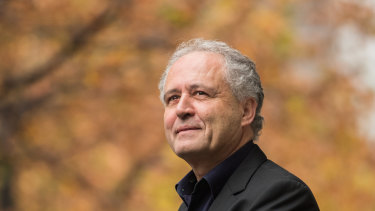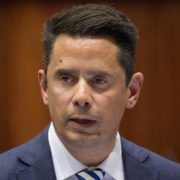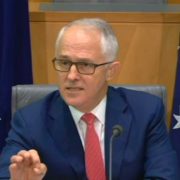‘Energy for democracy’: A plan for out-of-this-world solar power
Satisfying Australia’s energy needs while simultaneously putting the country on firmer national-security footing is a lofty goal.
That sort of “energy for democracy” is what Melbourne architect Serdar Baycan hopes to help create.
Tectura Architects MD Serdar Baycan has high hopes for a series of orbiting solar power stations. Credit:Jason South
Baycan has teamed up with one of the world’s foremost experts in space-based power to design and build a new system to supply energy for the country.
Their proposal is to test and then launch a series of orbiting solar power stations to capture sunlight, convert it to radio waves and send the energy down to terrestrial receivers to provide a source of endless clean electricity.
The plan to help Australia achieve total energy security and dramatically slash carbon emissions would also make the country less vulnerable to coercion in energy markets, the Melbourne architect said.
“This is energy for democracy,” said Baycan, acknowledging that space itself has become democratised, through greater commercialisation, new technology and new businesses.
Reusable launch systems, such as those pioneered by SpaceX, can dramatically lower the cost of putting objects in space from $US20,000 a kilogram of cargo a decade ago to closer to $US2000.
The boom in the commercial space industry now constitutes an estimated three-quarters of global space activity. Advances in 3D printing make for new possibilities in space construction, as well.
The effects of climate change, meanwhile, accelerate and the global demand for energy rises.
There’s another factor. National security: China also has plans to develop space-based power, potentially outmanoeuvring democracies on a technology they first invented.
Serdar’s partner on this project is California-based John Mankins, who, after a long career at NASA, wrote the book on space-based solar power. Literally. In 2014, he published The Case for Space Solar Power, which outlines the latest ideas on a technology undergoing constant improvements.
Baycan’s bet, as well as Mankins’, is that enough has changed on Earth since the idea was first developed in the 1960s to make space-based solar a reality for Australia and the US.
The technology is called Solar Power Satellite by means of Arbitrarily Large Phased Array (SPS-ALPHA), which refers to the innovative modular design of the cells used to capture solar power in orbit.
Australia would require 10 to 12 units, stationed in geo-synchronous orbit, at a production cost of $US10 billion each. Each one would be able to produce about 20 billion kilowatt hours a year, essentially indefinitely.
Mankins said the use of radio waves to transmit electricity from point to point, over “very long distances is proven technology.” The most recent time was a test at over 160 kilometres.
“Although space systems must be developed, the principle technologies for space solar power have all been proven, either in the laboratory or in terrestrial applications,” he said.
Baycan and Mankins met during at a National Space Society summit in the US last year, after Baycan was asked to join a team of US experts planning for human habitation of Mars.
Tectura Architects, Baycan’s firm, is known for its design of the Royal Melbourne Hospital in Parkville and the development of the Kingston Centre for Monash Health, among numerous other projects.
Baycan’s designs, drawing on his nearly three-decade career in scientific and educational architecture, were shortlisted in a competition.
“We spoke about how this is going to benefit both countries and create an extraordinary number of jobs,” said Baycan, who compared space-based power to the Snowy Hydro power scheme, which, after World War II, opened up swaths of the country for development.
“An Australian needs to be involved in effective and practical space industries that have implementation on Earth,” he said.
That’s a goal shared by the Australian Space Agency, formed last year, with an eye to helping develop local industry and expertise in order to get a bigger share of the growing US$345 billion global space industry.
Still, the challenges are daunting.
Space engineer Stephen Bornstein of Cyborg Dynamics Engineering, who is not involved in solar power, said falling launch costs had changed the economics of the business. Yet, the efficiency of space-based power would have to be proven in order for a project such as Baycan’s to succeed.
Solar power from space needed “a good, strong business case as to how that would be deemed a reasonable power source in comparison to ground-based solar”.
Baycan, however, believes the urgency created by climate change, a worsening international political situation, and a renewed focus on nation-state technological competition make the case for action.
“Standing still, Australia’s going to get run over,” he said.
Chris is Digital Foreign Editor at Fairfax Media.
Source: The Sydney Morning Herald
By Chris Zappone June 1, 2019 — 10.00pm



